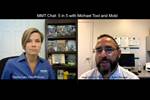
Current EAB member Dave DiCarlo shares his thoughts on the importance of a team to a successful manufacturer.
No matter how big or small a company is, a team environment helps produce a better product.
Although titles and roles are assigned to each employee to ensure that every task is monitored and achieved promptly, every individual plays a vital role in the final product. There should never be a feeling of superiority among coworkers. The key to achieving a team philosophy is promoting consistent, transparent communication among all employees. Communication is the key.
There is no such thing as a stupid question. Generally, people ask because they do not know the answer and they want to learn. So, it is more productive not to ridicule individuals no matter how naive the question may be perceived. For example, I’ve found that sometimes individuals struggle to move forward with direction if they have difficulty understanding the “why” behind the method of performing a particular task.
Explaining the whys and hows will help to alleviate that uncertainty and develop good habits. This may also lead to individuals speaking more freely, offering suggestions, thinking outside of the box and potentially providing more efficient ways to complete daily tasks. When individuals feel like part of the team, the benefits are substantial and will only produce a better product at the end of the day. And let’s face it, that is the end goal.
Explaining the whys and hows will help to alleviate that uncertainty and develop good habits. This may also lead to individuals speaking more freely, offering suggestions, thinking outside of the box and potentially providing more efficient ways to complete daily tasks.
A team philosophy also opens the doors for individuals to experience and learn the many different areas within the tool shop—a general laborer, machinist, designer, moldmaker, program manager, sales, etc. Communication and information will also help every employee better understand the daily struggles associated with each specific area of the shop.
With today’s part and tooling requirements, fast track program timing and constantly evolving industry, problem-solving is a daily part of the mold manufacturing process. So, the more voices, opinions and ideas the team communicates, the more efficient the results will be. This communication includes tooling issues, logistics, part feasibility and machining, to name a few.
I have worked within strong team cultures over the years, so I give credit to every colleague who has lent me their support. That support is what has helped me get to where I am today.
Related Content
-
Editorial Guidelines: Editorial Advisory Board
The Editorial Advisory Board of MoldMaking Technology is made up of authorities with expertise within their respective business, industry, technology and profession. Their role is to advise on timely issues, trends, advances in the field, offer editorial thought and direction, review and comment on specific articles and generally act as a sounding board and a conscience for the publication.
-
Think Safety: Eliminate Hazards Throughout the Shop
The tooling community is taking advantage of new products for safer mold shops and molding facilities.
-
Leading Mold Manufacturers Share Best Practices for Improving Efficiency
Precise Tooling Solutions, X-Cell Tool and Mold, M&M Tool and Mold, Ameritech Die & Mold, and Cavalier Tool & Manufacturing, sit down for a fast-paced Q&A focused on strategies for improving efficiencies across their operations.
















